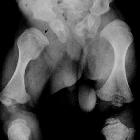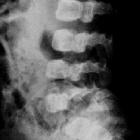kniest dysplasia


lateral X-rax
of lumbar spine in Kniest-Dysplasia showing coronal vertebral clefts

Kniest
dysplasia • Kniest dysplasia - head - Ganzer Fall bei Radiopaedia
Kniest dysplasia is rare type of short limbed skeletal dysplasia.
Pathology
Genetics
It is thought to carry an autosomal dominant inheritance. Kniest dysplasia is one of a spectrum of skeletal disorders caused by mutations in the COL2A1 gene, which encodes for type II collagen (therefore classified as a type II collagenopathy).
Radiographic features
General
Described features include
- non-ossified epiphyses
- absent ossification of the pubic bones
- delayed ossification of the femoral heads
- flatted ovoid vertebral bodies +/- coronal clefts
- dumb-bell shaped femurs
- short limbs: micromelia
- exaggerated metaphyseal flaring
- enlargement of the epiphysis with cloud-like calcifications at the physis
- metacarpal epiphyseal flattening
- enlargement of the metacarpal and proximal phalangeal ends
History and etymology
It is named after Wilhelm Kniest (1919-fl.1997) , a German pediatrician who first described the condition in 1952.
Siehe auch:
- Spondyloepiphysäre Dysplasie
- Skelettdysplasie
- koronare Wirbelspalten
- Metatrophe Dysplasie
- type II collagenopathy
und weiter:

 Assoziationen und Differentialdiagnosen zu Kniest-Syndrom:
Assoziationen und Differentialdiagnosen zu Kniest-Syndrom:


